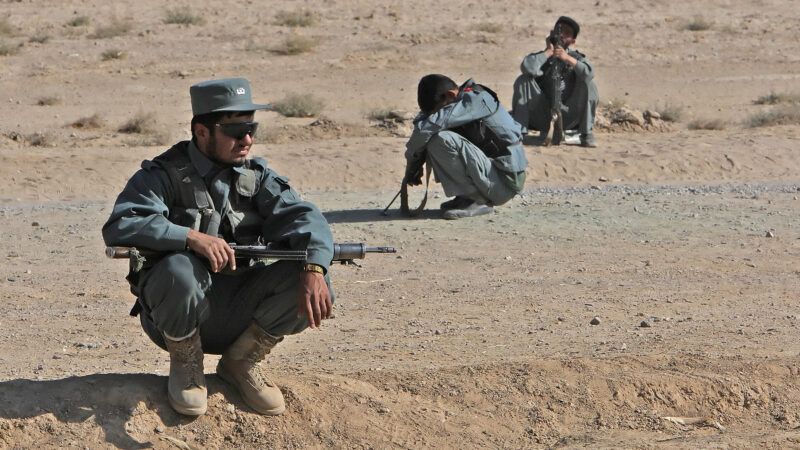U.S. Spent Over $21 Billion on Afghan Police, Got 'Barely Qualified Mall Guards'
New SIGAR findings shine a light on America’s dysfunctional efforts to train the Afghan National Police, which “actually contributed to increasing criminality” in Afghanistan.

After spending over $21 billion trying to train a national police force in Afghanistan, the United States splurged on equipment rather than focusing on institutional reform and churned out police trainees who were effectively "barely qualified mall guards," per an international observer. That's according to a sprawling new report published by the Special Inspector General for Afghanistan Reconstruction (SIGAR) that examines what went wrong in America's costly and ineffective management of the Afghan National Police (ANP).
The SIGAR report notes that "two decades of conflict had left little to reform in Afghanistan" by the early 2000s. "The entire criminal justice system—from police to courts to prisons—had to be rebuilt, and with the help of a largely illiterate Afghan population." The U.S. has no national police force and lacked any centralized standards or precedent to apply to the ANP. Training and advising fell to a piecemeal collection of departments and agencies, creating inefficient bureaucratic processes that butted up against deeply corrupt institutions in Afghanistan.
No effective, rights-protecting national police force has ever existed in Afghanistan. Both before and after U.S. involvement in the country began, the police had a reputation for arbitrary detentions, torture, and human rights abuses, which affected the Afghan population's receptiveness to newly trained officers. But the Afghans trained in American facilities were ill-equipped to perform tasks necessary to their jobs. It was so bad that in 2007, one international observer remarked, many graduates of U.S. training facilities were like "barely qualified mall guards."
Recruitment standards were lax and often colored by the corrupt Ministry of Interior, which prioritized personal and factional allegiance over legitimate qualifications. Further, "between 70 and 90 percent of the graduates of U.S. police training centers were illiterate." They were incapable of taking complex notes, reading warrants, or jotting down license plate numbers. Militia fighters also filled the ranks of the new police force, with one U.S.-contracted trainer noting, "we train who we can get." All the while, the yearly attrition rate for trainees floated around 15 percent (but may have been up to 30 percent).
The SIGAR report criticizes an approach to police assistance that "resembled failed efforts by the Soviet Union, other international donors, and former Afghan government administrations." The U.S. and its partners came to focus on "the hardware of police-building—equipment, infrastructure, organizational restructuring—over less tangible goals." That ultimately led to heavy investments in increased strength and a relative lack of attention to corruption and institutional abuse. But simple needs were still overlooked: In 2005, it was estimated that the ANP required 3.4 million basic items like communication equipment and cold-weather clothing.
This ultimately helped create a militarized police force, which was only exacerbated by the nature of instruction for trainees. "Police training courses put almost 90 percent of their emphasis on military skills such as weapons handling, roadblock establishment, and improvised explosive device identification. Only about 10 percent of the curriculum" focused on things like human rights or Afghanistan's constitution, while no time was spent on domestic violence or women's rights.
Eventually the Department of Defense took over the police-training initiative from the Department of State, though it lacked expertise in managing a civilian police force. That was largely done at the behest of former Defense Secretary Donald Rumsfeld, who lobbied for special funding from Congress as no such money existed in the Pentagon budget. "Since fiscal year 2005," the SIGAR report notes, "Congress has appropriated over $21 billion…specifically to support the ANP."
Despite all the money and time the U.S. devoted to building the ANP, the SIGAR report finds that the police force "actually contributed to increasing criminality." It was at least partially because of this dysfunction that the Taliban began to regain support among some Afghans, who were simply looking for someone to enforce law and order. State police had been "extorting and beating locals" and "regularly abducting and raping young boys." By the time President Joe Biden announced the U.S. troop withdrawal from Afghanistan in 2021, it was clear that the ANP was incapable of staving off disorder. When the Taliban took Kabul in August, they did so with effectively no resistance from Afghanistan's military or police.
Misconceptions and misplaced optimism plagued U.S. efforts to build a police force in Afghanistan. But sheer ignorance doomed the program too. "No one even knew how many police were actually on duty in Afghanistan" by 2006, years after the American training initiative began. As with so many other SIGAR reports, these findings drive home how futile nation-building efforts are when carried out by government bureaucrats who refuse to take stock of prohibitive realities in the country they hope to transform.


Show Comments (58)